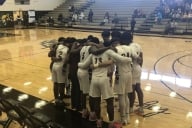You have /5 articles left.
Sign up for a free account or log in.
NATIONAL HARBOR, Md. – “The voice of the student-athlete” was a common refrain heard here Thursday, as members of the National Collegiate Athletic Association discussed the new legislative powers of its athletes -- as well as how to best publicize their college experiences to help combat the narrative that intercollegiate sports are exploitative.
“If you were to ask most college athletes if they felt exploited, they would guffaw,” said Nathan Hatch, president of Wake Forest University and chair of Division I’s Board of Directors. “They’re on full scholarship, they get all the academic services, they get meals.”
One thing many NCAA athletes haven’t had, however, is a real say in the creation of NCAA legislation.
Division III has allowed for students to vote on policy changes for years, but students in the NCAA’s two other divisions were only permitted to provide input. On Saturday, Division II will vote on legislation that creates two new student seats on its 27-seat management council. The students would have one combined vote. When the newly autonomous “Power Five” conferences meet to consider legislation this weekend, 15 of the new 80-member voting panel will be students.
Harris Pastides, president of the University of South Carolina and a member of the Division I Board of Directors, said it's enough voting power to "not just be lip service." (Critics like Ramogi Huma, founder of the College Players Association, have called it just that, however.)
“If they choose to wield their influence as a group or as a bloc, they will have a lasting impact on the policies of the organization," Pastides said.
The change in governance also created a student seat on the Division I Board of Directors. It's an opportunity for athletes to be “heard at all levels,” Kendall Spencer, a recent graduate of the University of New Mexico, told Oliver Luck, the NCAA's new vice president of regulatory affairs, during a keynote panel discussion titled “Perspectives of College Athletes."
“Our discussion was really only coming in on the back end," Spencer said. "This allows us an opportunity to have a voice in the preliminary discussions, not after everyone’s already made up their minds.”
But there’s also another reason for the NCAA’s desire to better amplify the voices of athletes. “If you ask student-athletes what they think about the college sports model,” Spencer said, “97 percent are going to come back and say that we love the model as it is.”
He was referring to the vast majority of college athletes, who largely exist outside the contentious debates surrounding issues that threaten the association’s long-held theoretical model of amateurism. And those are the students that the NCAA would like the public, Congress, and the Obama administration to have in mind when they debate ways to reform college athletics.
While addressing NCAA members during the opening business session of the association's annual meeting Thursday, Mark Emmert, president of the NCAA, said that the public’s perception of college sports is mostly limited to big-time college basketball and football.
“The public knows about what it sees on television,” he said. “What the public predominantly knows is Saturday afternoons in the fall. That’s what they see on a regular basis. That’s the perspective the world has on what is college sports and college athletes. It's about Division I football at the highest level and men's basketball being played in Division I. It sees the sliver of three percent."
Emmert said there are plenty of positive tales institutions can share that would cast college sports, and the association, in a more positive light. A video shown to the membership documented examples like a baseball coach who gave a kidney to one of his players and a football player who is also a physics tutor. But how, Emmert asked, “do you tell those stories?”
One possible answer to that question: lobbying. And lots of it.
The NCAA has spent more on lobbying efforts this year than in the last three combined. In just the first three fiscal quarters of 2014, according to OpenSecrets.Org, the association spent $470,000 lobbying lawmakers,let's say where these figures come from, and make case that it refers to what it has spent lobbying the federal government? dl**added -jn hiring outside lobbyists for the first time in more than a decade. With criticism and pressure coming from Congress and the White House, it’s not difficult to see why.
Several members of Congress have expressed interest in exploring the creation of a presidential commission on college sports, link to story we just did? dl got it to work; link added -jn which would examine issues like academic integrity and spending. Tom McMillen, a retired professional basketball player and a former member of Congress, has referred to the creation of such a commission as “a day of reckoning.”
At a press conference following the NCAA’s opening business session Thursday, Emmert said that he doesn’t consider the federal interest "to be a threat," and that he views it as a sign of how important college athletics are to the country. The association is not currently pushing for any specific legislation or changes in the law that would help preserve its amateurism model, he said, such as an antitrust exemption.
When asked why the NCAA was spending record amounts on lobbying, Emmert said the efforts were just an attempt to tell its side of the story to Congress.
"There's not always as strong information as we'd like," he said. "These issues are complicated, and we've simply been communicating with them about what is going on, and what's not going on, and how we're trying to constantly make things better."








